Abstract
Three positive selection procedures were developed for the isolation of plasmid-encoded mutants which were defective in the mannitol enzyme II (IIMtl) of the phosphotransferase system (mtlA mutants). The mutants were characterized with respect to the following properties: (i) fermentation, (ii) transport, (iii) phosphoenolpyruvate(PEP)-dependent phosphorylation, and (iv) mannitol-1-phosphate-dependent transphosphorylation of mannitol. Cell lysis in response to indole acrylic acid, which causes the lethal overexpression of the plasmid-encoded mtlA gene, was also scored. No correlation was noted between residual IIMtl activity in the mutants and sensitivity to the toxic effect of indole acrylic acid. Plasmid-encoded mutants were isolated with (i) total or partial loss of all activities assayed, (ii) nearly normal rates of transphosphorylation but reduced rates of PEP-dependent phosphorylation, (iii) nearly normal rates of PEP-dependent phosphorylation but reduced rates of transphosphorylation, and (iv) total loss of transport activity but substantial retention of both phosphorylation activities in vitro. A mutant of this fourth class was extensively characterized. The mutant IIMtl was shown to be more thermolabile than the wild-type enzyme, it exhibited altered kinetic behavior, and it was shown to arise by a single nucleotide substitution (G-895----A) in the mtlA gene, causing a single amino acyl substitution (Gly-253----Glu) in the permease. The results show that a single amino acyl substitution can abolish transport function without abolishing phosphorylation activity. This work serves to identify a site which is crucial to the transport function of the enzyme.
Full text
PDF

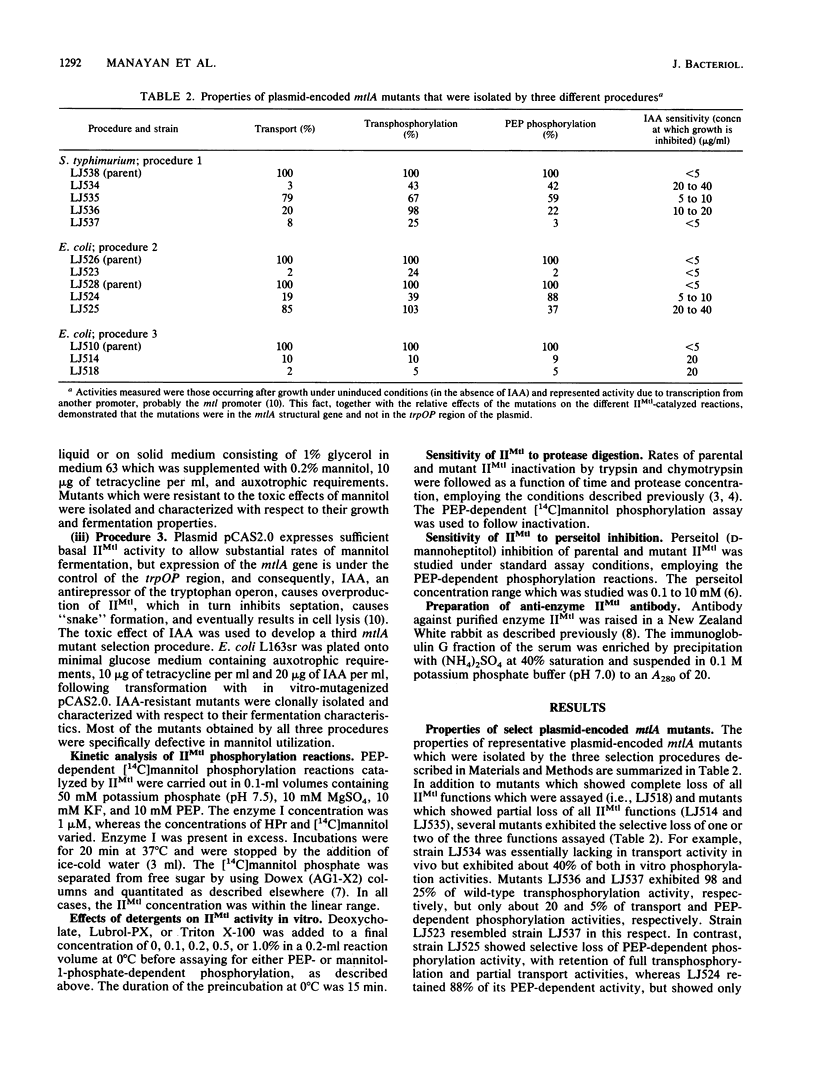
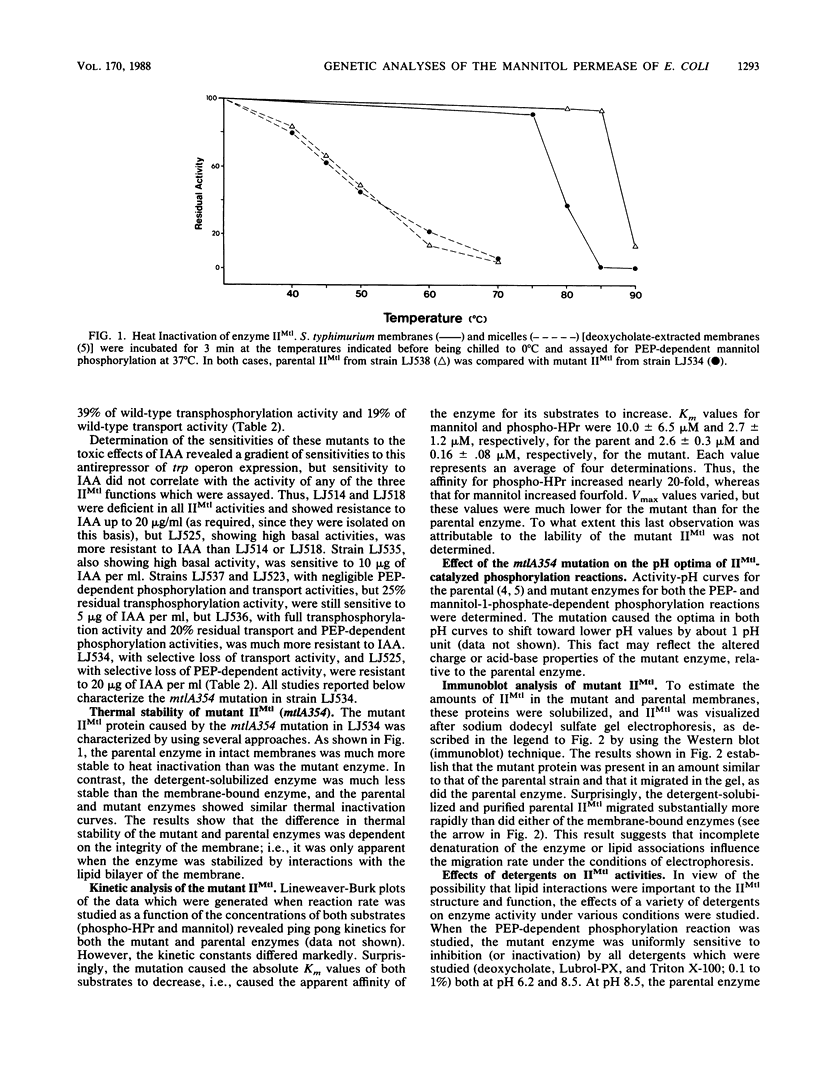
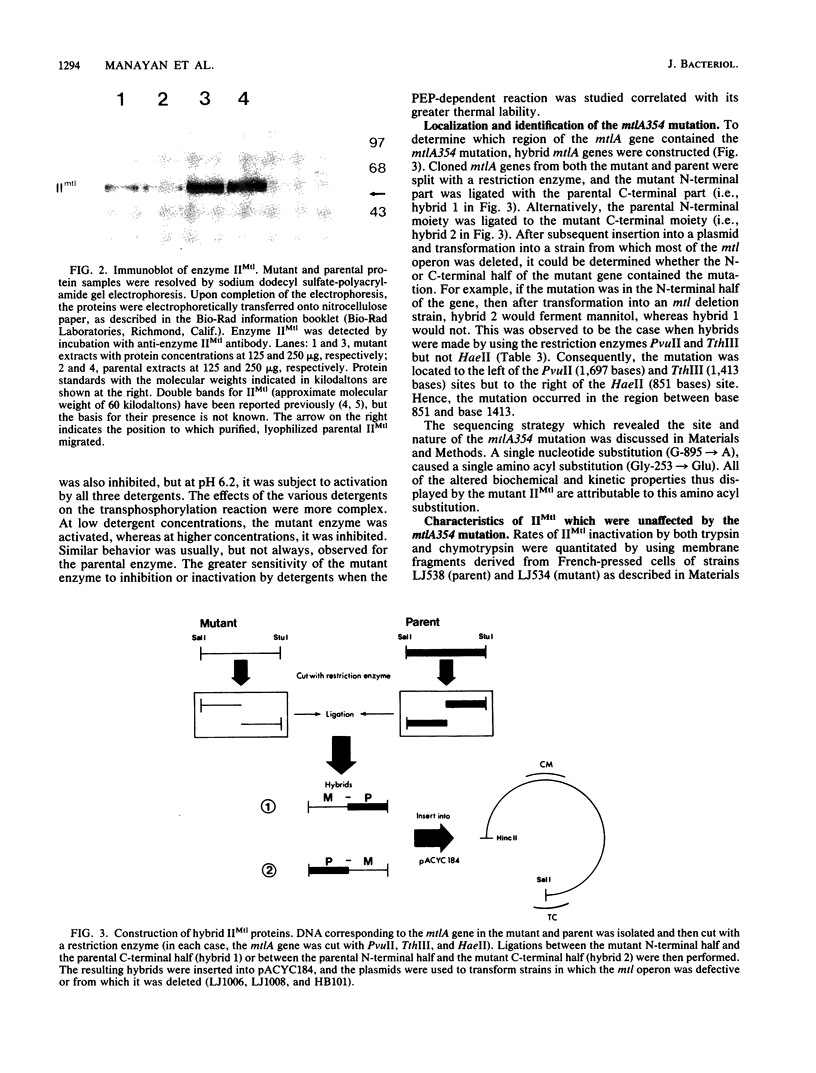
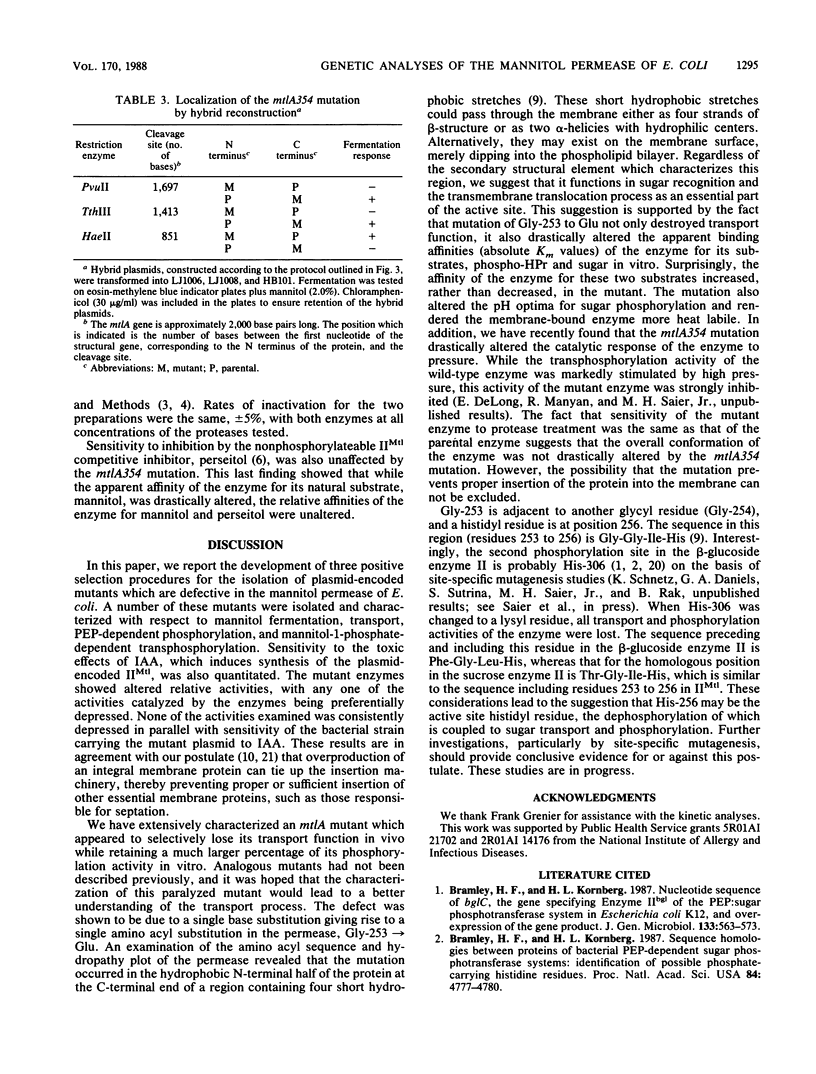
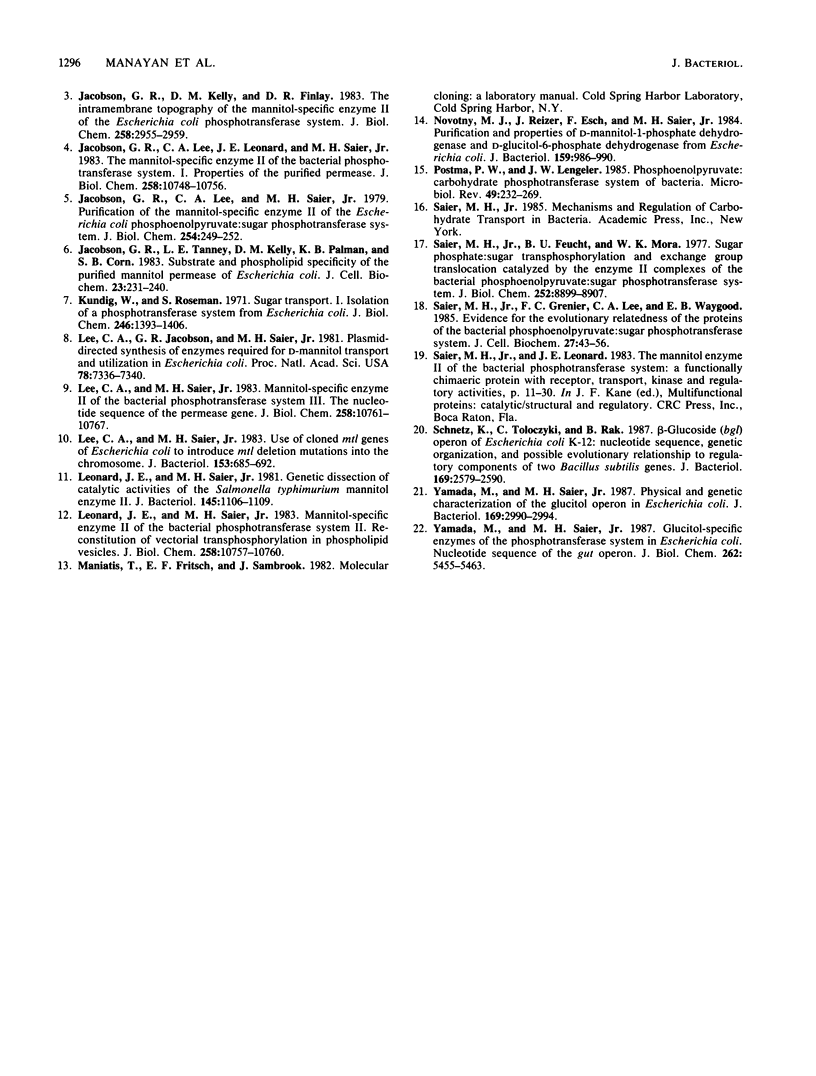
Images in this article
Selected References
These references are in PubMed. This may not be the complete list of references from this article.
- Bramley H. F., Kornberg H. L. Nucleotide sequence of bglC, the gene specifying enzymeIIbgl of the PEP:sugar phosphotransferase system in Escherichia coli K12, and overexpression of the gene product. J Gen Microbiol. 1987 Mar;133(3):563–573. doi: 10.1099/00221287-133-3-563. [DOI] [PubMed] [Google Scholar]
- Bramley H. F., Kornberg H. L. Sequence homologies between proteins of bacterial phosphoenolpyruvate-dependent sugar phosphotransferase systems: identification of possible phosphate-carrying histidine residues. Proc Natl Acad Sci U S A. 1987 Jul;84(14):4777–4780. doi: 10.1073/pnas.84.14.4777. [DOI] [PMC free article] [PubMed] [Google Scholar]
- Jacobson G. R., Kelly D. M., Finlay D. R. The intramembrane topography of the mannitol-specific enzyme II of the Escherichia coli phosphotransferase system. J Biol Chem. 1983 Mar 10;258(5):2955–2959. [PubMed] [Google Scholar]
- Jacobson G. R., Lee C. A., Leonard J. E., Saier M. H., Jr Mannitol-specific enzyme II of the bacterial phosphotransferase system. I. Properties of the purified permease. J Biol Chem. 1983 Sep 10;258(17):10748–10756. [PubMed] [Google Scholar]
- Jacobson G. R., Lee C. A., Saier M. H., Jr Purification of the mannitol-specific enzyme II of the Escherichia coli phosphoenolpyruvate:sugar phosphotransferase system. J Biol Chem. 1979 Jan 25;254(2):249–252. [PubMed] [Google Scholar]
- Jacobson G. R., Tanney L. E., Kelly D. M., Palman K. B., Corn S. B. Substrate and phospholipid specificity of the purified mannitol permease of Escherichia coli. J Cell Biochem. 1983;23(1-4):231–240. doi: 10.1002/jcb.240230120. [DOI] [PubMed] [Google Scholar]
- Kundig W., Roseman S. Sugar transport. I. Isolation of a phosphotransferase system from Escherichia coli. J Biol Chem. 1971 Mar 10;246(5):1393–1406. [PubMed] [Google Scholar]
- Lee C. A., Jacobson G. R., Saier M. H., Jr Plasmid-directed synthesis of enzymes required for D-mannitol transport and utilization in Escherichia coli. Proc Natl Acad Sci U S A. 1981 Dec;78(12):7336–7340. doi: 10.1073/pnas.78.12.7336. [DOI] [PMC free article] [PubMed] [Google Scholar]
- Lee C. A., Saier M. H., Jr Mannitol-specific enzyme II of the bacterial phosphotransferase system. III. The nucleotide sequence of the permease gene. J Biol Chem. 1983 Sep 10;258(17):10761–10767. [PubMed] [Google Scholar]
- Lee C. A., Saier M. H., Jr Use of cloned mtl genes of Escherichia coli to introduce mtl deletion mutations into the chromosome. J Bacteriol. 1983 Feb;153(2):685–692. doi: 10.1128/jb.153.2.685-692.1983. [DOI] [PMC free article] [PubMed] [Google Scholar]
- Leonard J. E., Saier M. H., Jr Genetic dissection of catalytic activities of the Salmonella typhimurium mannitol enzyme II. J Bacteriol. 1981 Feb;145(2):1106–1109. doi: 10.1128/jb.145.2.1106-1109.1981. [DOI] [PMC free article] [PubMed] [Google Scholar]
- Leonard J. E., Saier M. H., Jr Mannitol-specific enzyme II of the bacterial phosphotransferase system. II. Reconstitution of vectorial transphosphorylation in phospholipid vesicles. J Biol Chem. 1983 Sep 10;258(17):10757–10760. [PubMed] [Google Scholar]
- Novotny M. J., Reizer J., Esch F., Saier M. H., Jr Purification and properties of D-mannitol-1-phosphate dehydrogenase and D-glucitol-6-phosphate dehydrogenase from Escherichia coli. J Bacteriol. 1984 Sep;159(3):986–990. doi: 10.1128/jb.159.3.986-990.1984. [DOI] [PMC free article] [PubMed] [Google Scholar]
- Postma P. W., Lengeler J. W. Phosphoenolpyruvate:carbohydrate phosphotransferase system of bacteria. Microbiol Rev. 1985 Sep;49(3):232–269. doi: 10.1128/mr.49.3.232-269.1985. [DOI] [PMC free article] [PubMed] [Google Scholar]
- Saier M. H., Jr, Feucht B. U., Mora W. K. Sugar phosphate: sugar transphosphorylation and exchange group translocation catalyzed by the enzyme 11 complexes of the bacterial phosphoenolpyruvate: sugar phosphotransferase system. J Biol Chem. 1977 Dec 25;252(24):8899–8907. [PubMed] [Google Scholar]
- Saier M. H., Jr, Grenier F. C., Lee C. A., Waygood E. B. Evidence for the evolutionary relatedness of the proteins of the bacterial phosphoenolpyruvate:sugar phosphotransferase system. J Cell Biochem. 1985;27(1):43–56. doi: 10.1002/jcb.240270106. [DOI] [PubMed] [Google Scholar]
- Schnetz K., Toloczyki C., Rak B. Beta-glucoside (bgl) operon of Escherichia coli K-12: nucleotide sequence, genetic organization, and possible evolutionary relationship to regulatory components of two Bacillus subtilis genes. J Bacteriol. 1987 Jun;169(6):2579–2590. doi: 10.1128/jb.169.6.2579-2590.1987. [DOI] [PMC free article] [PubMed] [Google Scholar]
- Yamada M., Saier M. H., Jr Glucitol-specific enzymes of the phosphotransferase system in Escherichia coli. Nucleotide sequence of the gut operon. J Biol Chem. 1987 Apr 25;262(12):5455–5463. [PubMed] [Google Scholar]
- Yamada M., Saier M. H., Jr Physical and genetic characterization of the glucitol operon in Escherichia coli. J Bacteriol. 1987 Jul;169(7):2990–2994. doi: 10.1128/jb.169.7.2990-2994.1987. [DOI] [PMC free article] [PubMed] [Google Scholar]



